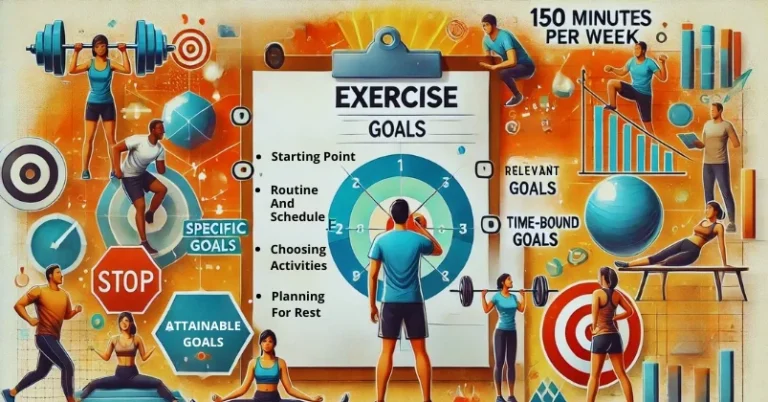Establishing Workout Goals: A Clear Path to Fitness Success
Establishing workout goals is a crucial step toward achieving a healthy lifestyle. Whether you are a beginner or an experienced fitness enthusiast, setting workout goals can help you stay focused, motivated, and on track. The process of establishing workout goals can be overwhelming, but with the right approach, it can be a rewarding experience.
Understanding the importance of workout goals is the first step toward establishing them. Workout goals help you define your fitness journey and give you direction. They also help you measure your progress and celebrate your achievements. Without clear and specific workout goals, it's easy to lose motivation and give up on your fitness journey.
In this article, we will explore the process of establishing workout goals. We will discuss the importance of SMART goal setting, types of workout goals, creating a personalized workout plan, monitoring and tracking progress, diet and hydration, consulting a healthcare provider, long-term fitness goals, and frequently asked questions. By the end of this article, you will have the knowledge and tools necessary to establish workout goals that are specific, measurable, achievable, relevant, and time-bound (SMART).
Key Takeaways
- Establishing workout goals is crucial for achieving a healthy lifestyle.
- SMART goal setting is important for creating specific, measurable, achievable, relevant, and time-bound workout goals.
- Creating a personalized workout plan, monitoring progress, and consulting a healthcare provider are essential steps toward achieving your fitness goals.
Understanding The Importance Of Workout Goals
Setting workout goals is an essential part of achieving good health and fitness. It provides direction, motivation, and a sense of accomplishment. Here are some reasons why understanding the importance of workout goals is crucial:
Motivation
Setting workout goals can help you stay motivated and focused. It gives you a clear idea of what you want to achieve and helps you track your progress. When you see progress, it can help boost your motivation and keep you on track.
Accountability
Having workout goals can make you accountable for your actions. It helps you to stay committed and avoid skipping workouts. When you set a goal, you are more likely to stick to your workout routine and make it a habit.
Measurable Progress
Workout goals provide a way to measure progress. By setting specific, measurable goals, you can track your progress and see how far you have come. This can help you stay motivated and celebrate your achievements.
Improved Health
Setting workout goals is an important part of maintaining good health. Regular exercise can help reduce the risk of chronic diseases such as heart disease, diabetes, and obesity. By setting workout goals, you can ensure that you are getting the exercise you need to stay healthy.
In conclusion, understanding the importance of workout goals is crucial for achieving good health and fitness. It provides motivation, accountability, measurable progress, and improved health. By setting specific, measurable goals, you can stay on track and achieve the results you desire.
Smart Goal Setting For Workouts
When it comes to establishing workout goals, it's essential to set SMART goals. SMART stands for Specific, Measurable, Attainable, Relevant, and Time-Bound. Following these guidelines ensures that your goals are well-defined and achievable.
Specific Goals
Specific goals are clear and well-defined. A specific goal should answer the following questions: What do you want to achieve? Why is it important to you? How will you achieve it? For example, instead of setting a goal to “get fit,” a specific goal would be to “run a 5K in under 30 minutes.”
Measurable Goals
Measurable goals allow you to track your progress and determine whether you're on track to achieve your goal. To make a goal measurable, you need to quantify it. For example, instead of setting a goal to “do more push-ups,” a measurable goal would be to “do 20 push-ups in a row.”
Attainable Goals
Attainable goals are challenging but achievable. Setting a goal that is too easy won't push you to improve, but setting a goal that is impossible to achieve will only lead to frustration. To make a goal attainable, consider your current fitness level, available resources, and time frame.
Relevant Goals
Relevant goals are aligned with your overall fitness goals and priorities. A relevant goal should be meaningful and important to you. For example, if your goal is to improve your cardiovascular health, setting a goal to increase your bench press weight may not be relevant.
Time-Bound Goals
Time-bound goals have a specific deadline or time frame for achievement. Setting a deadline creates a sense of urgency and motivates you to take action. To make a goal time-bound, set a specific date for achievement. For example, instead of setting a goal to “run more,” a time-bound goal would be to “run a 10K race in three months.”
In summary, setting SMART goals is crucial for establishing workout goals. By setting specific, measurable, attainable, relevant, and time-bound goals, you'll be able to track your progress and achieve your fitness goals.
Types Of Workout Goals
When it comes to establishing workout goals, there are several different types to consider. The four main types of workout goals are weight loss goals, strength training goals, marathon training goals, and flexibility goals.
Weight Loss Goals
Weight loss goals are one of the most common types of workout goals. They typically involve setting a target weight and a timeline for achieving that weight. It is important to set realistic and achievable goals to avoid disappointment or injury. A healthy rate of weight loss is around 1-2 pounds per week. To achieve weight loss goals, a combination of cardio and strength training exercises is recommended.
Strength Training Goals
Strength training goals are focused on building muscle and increasing strength. These goals can be achieved through weightlifting, bodyweight exercises, or resistance band workouts. It is important to set specific goals, such as lifting a certain weight or completing a certain number of reps, to track progress and stay motivated.
Marathon Training Goals
Marathon training goals are focused on preparing for a long-distance running event, such as a half or full marathon. These goals typically involve gradually increasing running distance and time over several months. It is important to incorporate strength training and stretching exercises to prevent injury and improve performance.
Flexibility Goals
Flexibility goals are focused on improving the range of motion and reducing the risk of injury. These goals can be achieved through stretching exercises, such as yoga or Pilates. It is important to set specific goals, such as touching toes or holding a certain pose, to track progress and stay motivated.
In summary, establishing workout goals is crucial to staying motivated and achieving desired results. By setting specific and achievable goals, individuals can track progress and stay on track with their fitness journey. Whether the goal is to lose weight, build strength, run a marathon, or improve flexibility, there are many different types of workout goals to consider.
Creating A Personalized Workout Plan
When it comes to establishing workout goals, creating a personalized workout plan is essential. A personalized plan can help you achieve your fitness goals more effectively and efficiently. Here are some steps to help you create a personalized workout plan.
Assessing Your Current Fitness Level
Before creating a workout plan, it's important to assess your current fitness level. This includes evaluating your cardiovascular endurance, muscular strength, and flexibility. You can use various methods to assess your fitness level, such as body composition tests, strength tests, and flexibility tests. Once you have a clear understanding of your current fitness level, you can develop a specific plan that addresses your strengths and weaknesses.
Developing A Specific Plan
A specific plan is essential to achieving your fitness goals. Your plan should include both cardiovascular exercise and resistance training. Cardiovascular exercise includes moderate aerobic activity and aerobic activity, such as running, cycling, and swimming. Resistance training includes exercises that use weights, resistance bands, or body weights, such as squats, lunges, and push-ups.
When developing your plan, it's important to consider your fitness goals, schedule, and preferences. For example, if your goal is to lose weight, you may want to incorporate more cardiovascular exercise into your plan. If you have a busy schedule, you may need to find ways to incorporate exercise into your daily routine, such as taking the stairs instead of the elevator.
Incorporating Different Exercises
To prevent boredom and plateauing, it's important to incorporate different exercises into your plan. This can include changing up your cardio routine, trying new resistance exercises, or incorporating functional movements, such as kettlebell swings or burpees. It's also important to gradually increase the intensity and duration of your workouts to continue challenging your body.
In conclusion, creating a personalized workout plan is essential to achieving your fitness goals. By assessing your current fitness level, developing a specific plan, and incorporating different exercises, you can create a plan that is tailored to your needs and preferences. Remember to be consistent and patient in your workouts, and you will see progress over time.
Monitoring And Tracking Progress
One of the most important aspects of establishing workout goals is monitoring and tracking progress. This helps you stay motivated and focused on your goals. Here are some effective ways to track your progress:
Using Fitness Apps
Fitness apps are a great way to track your progress. They allow you to monitor your workouts, set goals, and track your progress over time. Some popular fitness apps include MyFitnessPal, Fitbit, and Nike Training Club. These apps offer a wide range of features including tracking your workouts, setting goals, and providing personalized recommendations based on your progress.
Setting Up A Reward System
Setting up a reward system can help you stay motivated and committed to your workout goals. Rewards can be anything from treating yourself to a massage or a new workout outfit. The key is to choose rewards that are meaningful to you and that will keep you motivated.
Accountability And Commitment
Accountability is crucial when it comes to achieving your workout goals. One way to stay accountable is to find a workout partner or join a fitness group. This will help you stay committed to your goals and provide you with support and motivation along the way.
In addition, it's important to commit to your workout schedule. Make sure to schedule your workouts in advance and stick to them. This will help you establish a routine and make it easier to stay committed to your goals.
Overall, monitoring and tracking your progress is essential to achieving your workout goals. By using fitness apps, setting up a reward system, and staying accountable and committed, you can stay motivated and focused on your goals.
Diet And Hydration
When it comes to achieving your workout goals, diet and hydration play a crucial role in ensuring that you can perform at your best. Here are some important factors to consider:
Importance Of Protein Intake
Protein is essential for building and repairing muscles, making it an important part of any workout regimen. Aim to consume lean protein sources such as chicken, fish, and legumes. It's also important to consume protein within 30 minutes of completing your workout to aid in muscle recovery and growth.
Avoiding Added Sugars
Added sugars can sabotage your workout goals by providing empty calories that offer little nutritional value. Be mindful of added sugars in processed foods and drinks, and opt for whole foods instead.
The Role Of Hydration
Staying hydrated is crucial for optimal workout performance. Water is the best choice for hydration, but you can also consume other beverages such as herbal tea or coconut water. Aim to consume at least 8 glasses of water per day, and increase your intake during and after workouts to replace lost fluids.
| Beverage | Serving Size | Calories |
| Water | 8 oz | 0 |
| Coconut Water | 8 oz | 45 |
| Herbal Tea | 8 oz | 0 |
| Sports Drink | 8 oz | 50-80 |
In conclusion, paying attention to your diet and hydration is crucial for achieving your workout goals. By consuming lean protein sources, avoiding added sugars, and staying hydrated, you can optimize your performance and reach your fitness goals.
Consulting A Healthcare Provider
Before starting any fitness regimen, it is recommended to consult a healthcare provider, especially if you have any underlying health conditions or injuries. A healthcare provider can assess your current health status, identify any potential risks, and provide guidance on how to safely achieve your fitness goals.
According to a special health report by Harvard Medical School, consulting a healthcare provider is particularly important if you have any of the following risk factors:
- A history of heart disease, stroke, or other cardiovascular conditions
- High blood pressure or high cholesterol
- Diabetes or prediabetes
- Obesity or a high body mass index (BMI)
- Chronic obstructive pulmonary disease (COPD) or asthma
- Arthritis or joint pain
- Back pain or other musculoskeletal conditions
Your healthcare provider can also help you set realistic fitness goals based on your individual needs and abilities. They may recommend specific types of exercise, such as aerobic activity, strength training, or flexibility exercises, depending on your goals and health status.
It is important to be honest with your healthcare provider about your current fitness level, any previous injuries or health conditions, and any medications you are currently taking. This information can help them provide personalized recommendations and ensure your safety during exercise.
In summary, consulting a healthcare provider before starting a workout regimen is an important step in achieving your fitness goals safely and effectively. They can assess your health status, identify any potential risks, and provide personalized guidance to help you reach your goals.
Long-Term Fitness Goals
When it comes to establishing workout goals, it's important to have a mix of short-term and long-term objectives. While short-term goals help keep you motivated and on track, long-term goals provide a sense of direction and purpose. Long-term goals are those that take more than six months to achieve, and they can be aesthetic, performance-based, or a combination of both.
Building Muscle
One common long-term fitness goal is building muscle. This goal involves increasing muscle mass and strength through resistance training. To achieve this goal, it's important to focus on progressive overload, which means gradually increasing the weight, reps, or sets of your exercises over time. It's also important to consume enough protein to support muscle growth and recovery.
Behavioral Change
Another important aspect of long-term fitness goals is behavioral change. This involves making sustainable changes to your lifestyle that support your health and fitness goals. For example, if your long-term goal is to lose weight, you might need to make changes to your diet and exercise routine. To make these changes stick, it's important to focus on small, manageable steps and to track your progress along the way.
Habit Formation
Habit formation is another key factor in achieving long-term fitness goals. Habits are automatic behaviors that are triggered by specific cues, such as time of day or location. By forming healthy habits, you can make it easier to stick to your fitness routine over the long term. For example, if you want to make exercise a habit, you might try scheduling your workouts at the same time each day or packing your gym bag the night before.
Sleep
Finally, getting enough sleep is crucial for achieving long-term fitness goals. Sleep is when your body repairs and regenerates, and it's essential for muscle growth and recovery. Aim for seven to nine hours of sleep per night, and try to establish a regular sleep schedule to help regulate your body's internal clock.
In summary, long-term fitness goals are an important part of establishing a successful workout routine. By focusing on building muscle, making sustainable behavioral changes, forming healthy habits, and getting enough sleep, you can set yourself up for long-term success.
FAQs
Setting achievable fitness goals is crucial to staying motivated and making progress. Here are some tips for setting effective fitness goals:
1. Make your goals specific and measurable. Instead of saying “I want to get in shape,” set a specific goal like “I want to run a 5k in under 30 minutes.”
2. Set realistic goals. Don't set yourself up for failure by setting goals that are too challenging or unrealistic.
3. Write down your goals and track your progress. This will help you stay accountable and motivated.
To create a workout plan that aligns with your fitness goals, you should:
1. Determine your current fitness level. This will help you determine the appropriate intensity and frequency of your workouts.
2. Choose exercises that target the specific muscle groups or fitness components you want to improve.
3. Gradually increase the intensity and duration of your workouts over time.
4. Incorporate a variety of exercises to prevent boredom and ensure a well-rounded workout.
Some common obstacles people face when trying to achieve their fitness goals include:
1. Lack of time
2. Lack of motivation
3. Injury or illness
4. Plateaus in progress
To overcome these obstacles, try setting realistic goals, finding a workout buddy, or seeking professional help from a personal trainer or physical therapist.
Measuring progress towards your fitness goals is important to stay motivated and track your success. Here are some ways to measure progress:
1. Track your weight, body measurements, or body fat percentage.
2. Time yourself during workouts to see if you're improving.
3. Keep a workout log to track your progress over time.
SMART stands for Specific, Measurable, Achievable, Relevant, and Time-bound. Here are some examples of SMART fitness goals:
1. I will run a 5k in under 30 minutes by the end of the month.
2. I will complete 10 push-ups in a row within 2 weeks.
3. I will lose 5 pounds in the next month by following a healthy diet and exercising 3 times per week.
Staying motivated to achieve your fitness goals can be challenging, but here are some strategies that may help:
1. Find a workout buddy or accountability partner.
2. Reward yourself for reaching milestones or achieving goals.
3. Mix up your workouts to prevent boredom.
4. Focus on the positive changes you're making in your life.








